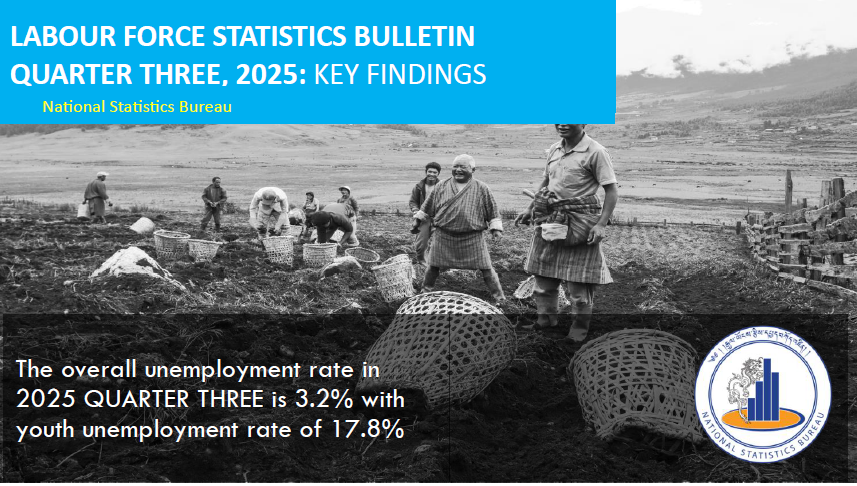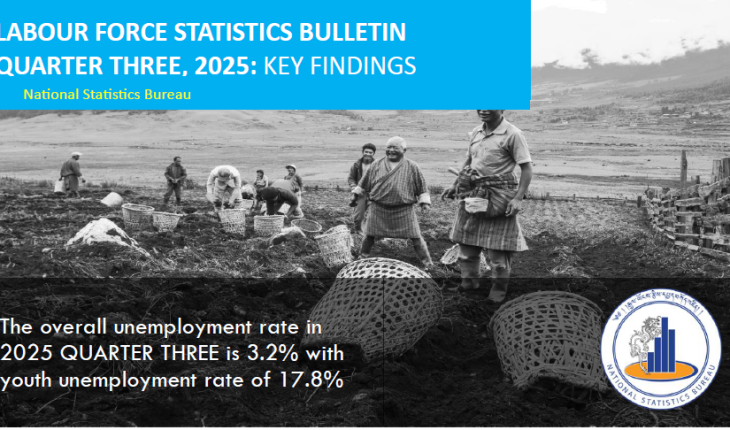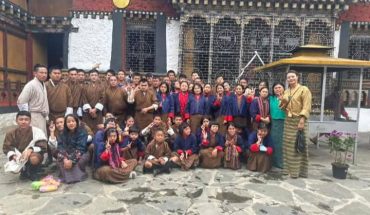
Gradual improvement in labour participation, but gender and youth disparities persist
TIL BDR GHALLEY | Thimphu
Bhutan’s overall unemployment rate has risen marginally to 3.2 percent in the third quarter of 2025, compared to 2.9 percent recorded in the previous quarter, according to the Labour Force Statistics Bulletin released by the National Statistics Bureau (NSB). Despite the increase, the Bureau stated that “the overlapping confidence intervals indicate that the observed difference is not statistically significant.” However, the persistence of high youth unemployment remains a major concern, with the rate standing at 17.8 percent, more than five times higher than the national average.
According to the survey, 77.6 percent of Bhutan’s total population, or 608,117 people, were aged 15 years and above, forming the country’s working-age population. Among them, 52 percent were male and 48 percent female, while 38 percent resided in urban areas and 62 percent in rural areas. Out of this working-age population, 398,039 individuals were identified as economically active, with males accounting for 59.4 percent and female’s 40.6 percent. Economic activity was notably higher in rural areas with 64.5 percent as compared to urban areas of 35.5 percent.
The Labour Force Participation Rate (LFPR) — the proportion of the working-age population that is economically active — stood at 65.5 percent in the third quarter of 2025. This marks a 0.4 percentage point increase compared to the same quarter in 2024 and a 0.2 percentage point rise from the previous quarter, indicating steady improvement in labour market engagement. Participation remains higher among males, at 74.2 percent, than females, at 55.8 percent, and higher in rural areas with 68.1 percent than urban areas of 61.1 percent.
The inactivity rate, which measures those outside the labour force, fell slightly by 0.22 percentage points from the previous quarter and by 0.4 percentage points year-on-year, standing at 34.5 percent. However, gender gaps remain pronounced. The female inactivity rate is 44.2 percent, nearly 18.4 percentage points higher than the male rate of 25.8 percent. The report identifies education and family duties as the primary reasons for non-participation in the labour force. “A large share of males reported studies or training as their main reason, while females predominantly cited household and family responsibilities,” the NSB stated. Additionally, around 20.5 percent of individuals outside the labour force reported retirement, pension, or disability as their reason for non-participation.
The overall employment rate remained high at 96.8 percent in Q3 2025, showing only a slight decline from 97.1 percent in the previous quarter. Compared to the same period last year, the rate was also marginally lower, reflecting small fluctuations in the employment situation. Employment levels were higher for males with 97.8 percent than females with 95.3 percent, and higher in rural areas of 97.9 percent than urban areas of 94.6 percent. The report attributes this to the engagement of a large proportion of rural residents in own-account agricultural work, particularly farming on their own land.
Among the 385,131 employed persons, the agriculture sector employed 42.7 percent, followed by services with 40.7 percent and industry with 16.6 percent. Employment patterns show that more males are engaged in services and industry, while females are predominantly found in agriculture. The nature of employment also varies across groups: 42.4 percent of the employed population were paid employees, 32.6 percent were own-account workers, and 25 percent were family contributing workers. The NSB highlighted “a notable gender disparity across employment categories,” suggesting persistent differences in the type of work undertaken by men and women.
Income disparities continue to mark Bhutan’s labour landscape. The mean monthly labour income for employed persons stood at Nu. 25,728. Male workers earned an average of Nu. 28,007, while female workers earned Nu. 21,421, resulting in a gender income gap of Nu. 6,586. The gap persists across both urban and rural areas, where males consistently earn higher wages than their female counterparts.
Despite the overall stability of Bhutan’s labour market, youth unemployment remains a pressing challenge. Youths aged 15–24 years made up 44.2 percent of all unemployed persons actively seeking work in Q3 2025. The youth unemployment rate increased to 17.8 percent, reflecting a 0.5 percentage point rise from the previous quarter and a 1.3 percentage point increase compared to the same period in 2024. Unemployment is highest among those aged 20–24 years, after which it declines steadily and levels off from around age 45 onwards. According to the report, “this decline in unemployment rate with age may reflect typical life-cycle patterns of labour market entry, accumulation of work experience, and increasing job stability.”
The survey further examined reasons for unemployment, revealing that recently completed studies with 25.4 percent, lack of adequate qualifications with 19.9 percent, qualification mismatch with 11.7 percent and lack of experience with 11.5 percent were the most commonly cited causes. The NSB observed that “this pattern of reasons for unemployment is consistent across both male and female respondents, indicating similar challenges faced by both genders in the labour market.” Duration of unemployment data shows that 61.5 percent of unemployed persons had been jobless for less than six months, while 38.5 percent were unemployed for six months or more. Alarmingly, 18.6 percent of unemployed persons had been without work for over a year, classifying them as long-term unemployed.
The NSB emphasized that all findings adhere to International Labour Organization (ILO) standards, ensuring comparability with global benchmarks. NSB reaffirmed the critical importance of the survey, noting that “the Labour Force Survey (LFS) plays a vital role in generating key labour market indicators that inform national planning and policy formulation. Data from the LFS support the monitoring and evaluation of the country’s economic performance and contribute to the design of employment-related programmes and other socio-economic initiatives.”
While Bhutan’s overall employment situation remains strong, the persistence of youth unemployment and gender disparities in both participation and income reveal underlying structural challenges. The slight increase in unemployment from the previous quarter, though statistically insignificant, underscores the need for continued policy attention toward improving job opportunities, enhancing skills development, and supporting young job seekers’ transition into the labour market.
The Quarter Three 2025 Labour Force Statistics Bulletin paints a nuanced picture of Bhutan’s labour market—one marked by stability and resilience, yet shadowed by inequality and vulnerability. The data reveal that although most Bhutanese are gainfully employed, the nation continues to grapple with imbalances in gender participation, income distribution, and youth employment. As Bhutan progresses toward inclusive economic growth, addressing these disparities will remain central to ensuring a more equitable and sustainable labour market for all.




